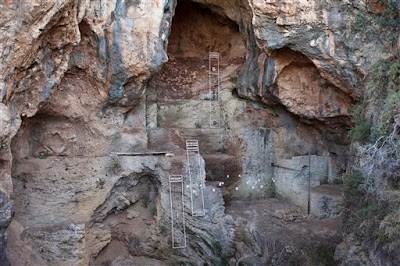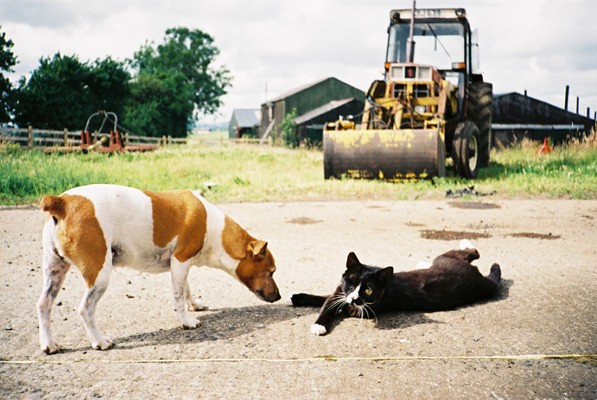If you thought recycling was just a modern phenomenon championed by environmentalists and concerned urbanites - think again.
 |
| This
Wednesday, Oct. 9, 2013 photo shows the stone age recycling site cave at
the north of Israel next to the city of Zichron Yaakov. There is
mounting evidence that already hundreds of thousands of years ago our
prehistoric ancestors learned to recycle the objects they used in their
daily lives, say researchers gathered here for an international
conference [Credit: AP/Dan Balilty] |
There is mounting evidence that hundreds of thousands of years ago, our
prehistoric ancestors learned to recycle the objects they used in their
daily lives, say researchers gathered at an international conference in
Israel.
"For the first time we are revealing the extent of this phenomenon, both
in terms of the amount of recycling that went on and the different
methods used," said Ran Barkai, an archaeologist and one of the
organizers of the four-day gathering at Tel Aviv University that ended
Thursday.
Just as today we recycle materials such as paper and plastic to
manufacture new items, early hominids would collect discarded or broken
tools made of flint and bone to create new utensils, Barkai said.
The behavior "appeared at different times, in different places, with
different methods according to the context and the availability of raw
materials," he told The Associated Press.
From caves in Spain and North Africa to sites in Italy and Israel,
archaeologists have been finding such recycled tools in recent years.
The conference, titled "The Origins of Recycling," gathered nearly 50
scholars from about 10 countries to compare notes and figure out what
the phenomenon meant for our ancestors.
Recycling was widespread not only among early humans but among our
evolutionary predecessors such as Homo erectus, Neanderthals and other
species of hominids that have not yet even been named, Barkai said.
Avi Gopher, a Tel Aviv University archaeologist, said the early
appearance of recycling highlights its role as a basic survival
strategy. While they may not have been driven by concerns over pollution
and the environment, hominids shared some of our motivations, he said.
"Why do we recycle plastic? To conserve energy and raw materials,"
Gopher said. "In the same way, if you recycled flint you didn't have to
go all the way to the quarry to get more, so you conserved your energy
and saved on the material."
 |
| This
Wednesday, Oct. 9, 2013 photo shows the stone age recycling site cave at
the north of Israel next to the city of Zichron Yaakov. There is
mounting evidence that already hundreds of thousands of years ago our
prehistoric ancestors learned to recycle the objects they used in their
daily lives, say researchers gathered here for an international
conference. (AP Photo/Dan Balilty) |
Some cases may date as far back as 1.3 million years ago, according to
finds in Fuente Nueva, on the shores of a prehistoric lake in southern
Spain, said Deborah Barsky, an archaeologist with the University of
Tarragona. Here there was only basic reworking of flint and it was hard
to tell whether this was really recycling, she said.
"I think it was just something you picked up unconsciously and used to
make something else," Barsky said. "Only after years and years does this
become systematic."
That started happening about half a million years ago or later, scholars said.
For example, a dry pond in Castel di Guido, near Rome, has yielded bone
tools used some 300,000 years ago by Neanderthals who hunted or
scavenged elephant carcasses there, said Giovanni Boschian, a geologist
from the University of Pisa.
"We find several levels of reuse and recycling," he said. "The bones
were shattered to extract the marrow, then the fragments were shaped
into tools, abandoned, and finally reworked to be used again."
At other sites, stone hand-axes and discarded flint flakes would often
function as core material to create smaller tools like blades and
scrapers. Sometimes hominids found a use even for the tiny flakes that
flew off the stone during the knapping process.
At Qesem cave, a site near Tel Aviv dating back to between 200,000 and
420,000 years ago, Gopher and Barkai uncovered flint chips that had been
reshaped into small blades to cut meat - a primitive form of cutlery.
Some 10 percent of the tools found at the site were recycled in some
way, Gopher said. "It was not an occasional behavior; it was part of the
way they did things, part of their way of life," he said.
He said scientists have various ways to determine if a tool was
recycled. They can find direct evidence of retouching and reuse, or they
can look at the object's patina - a progressive discoloration that
occurs once stone is exposed to the elements. Differences in the patina
indicate that a fresh layer of material was exposed hundreds or
thousands of years after the tool's first incarnation.
Some participants argued that scholars should be cautious to draw
parallels between this ancient behavior and the current forms of
systematic recycling, driven by mass production and environmental
concerns.
"It is very useful to think about prehistoric recycling," said Daniel
Amick, a professor of anthropology at Chicago's Loyola University. "But I
think that when they recycled they did so on an `ad hoc' basis, when
the need arose."
Participants in the conference plan to submit papers to be published
next year in a special volume of Quaternary International, a
peer-reviewed journal focusing on the study of the last 2.6 million
years of Earth's history.
Norm Catto, the journal's editor in chief and a geography professor at
Memorial University in St John's, Canada, said that while prehistoric
recycling had come up in past studies, this was the first time experts
met to discuss the issue in such depth.
Catto, who was not at the conference, said in an email that studying
prehistoric recycling could give clues on trading links and how much
time people spent at one site.
Above all, he wrote, the phenomenon reflects how despite living
millennia apart and in completely different environments, humans appear
to display "similar responses to the challenges and opportunities
presented by life over thousands of years."





































